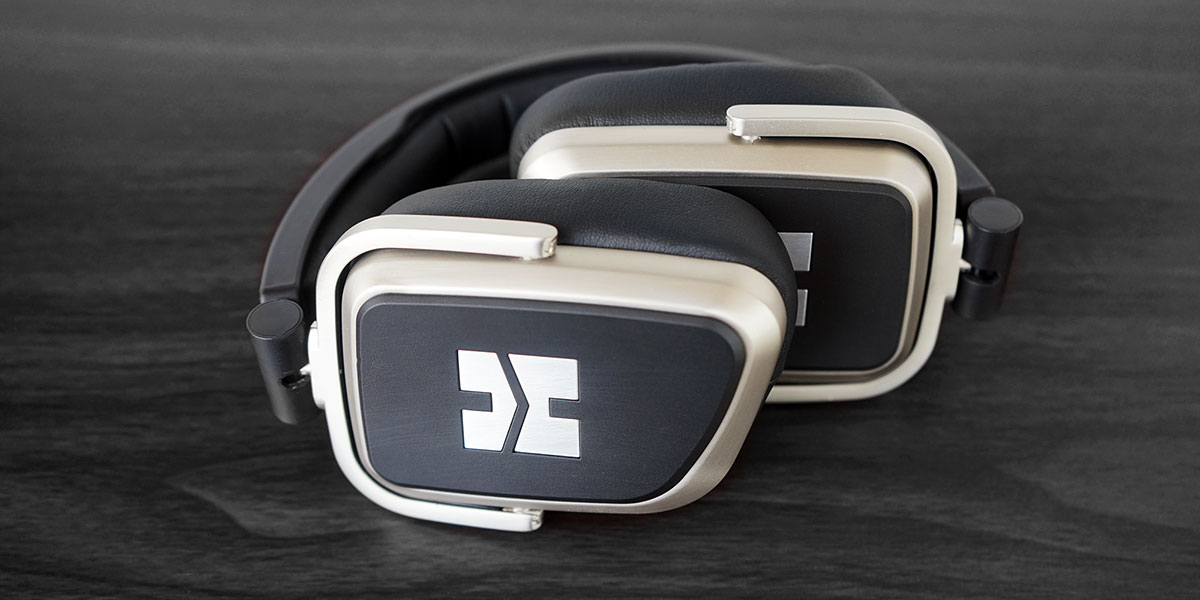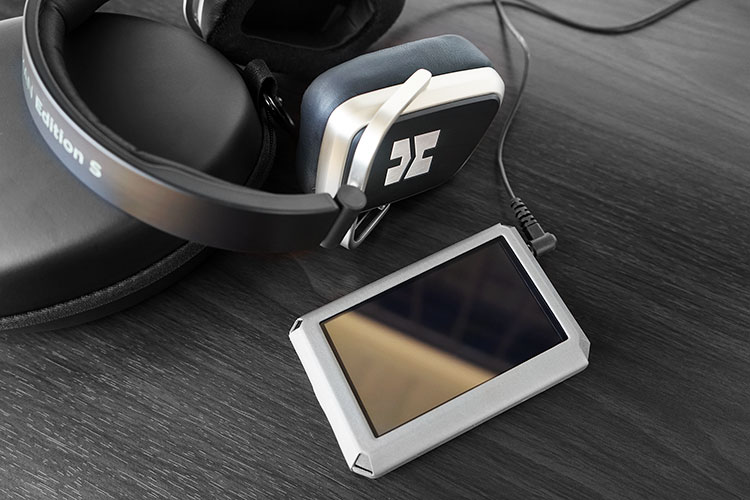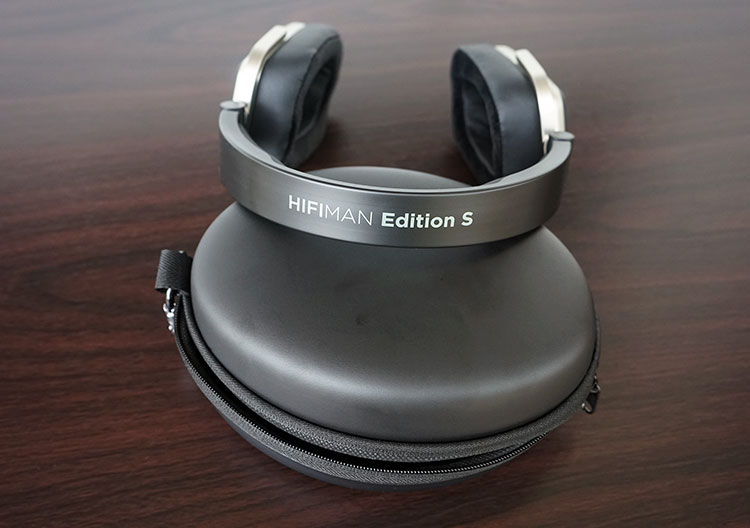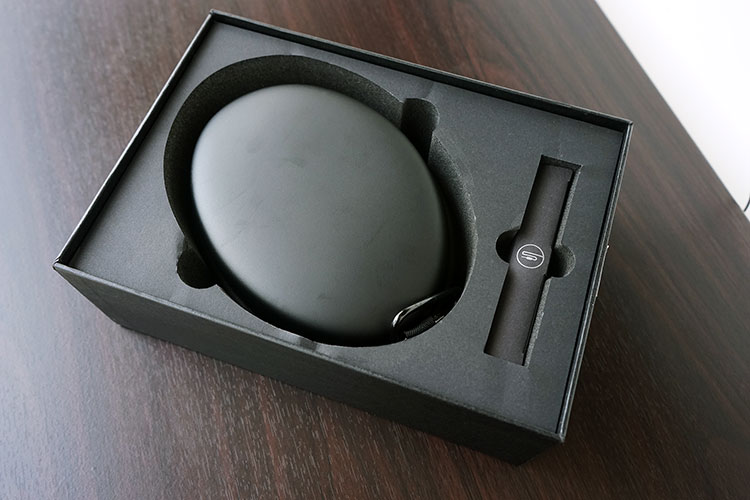Sound Impressions
Summary
Closed
The tonal difference between open and closed is not what I expected at all. With the plates on you do get more of a closed-in quality with a neutral and relatively balanced presentation but with a slight focus more on the mid-range and treble over any hard-hitting bass performance.
Clean and clear is how I would define it with a little bit of zip and sparkle in the top end. It doesn’t have the thickest note and the bass is just neutral at best but it has a very good turn of speed, with good articulation and decent definition.
Vocal presence is a mixed bag with female vocals from the likes of Ellie Goulding with her breathless high pitched style sounding a touch harsh and sibilant but on the other hand, more soulful vocal sets like Katharine McPhee and Hillary Scott sounding more refined and controlled.
Overall the closed Edition S has a fairly coherent if slightly intimate soundstage that has a bit more depth than width but nothing inconsistent with a closed headphone sound. It has the edge in clarity and definition over the open variant but sounds a bit more brittle and unforgiving in return especially in the lower treble.
Open
Take the plates off and things get a bit warmer and a bit more musical sounding. Oddly mid-bass gets a bit of a boost and the treble sounds a bit more relaxed but still present. I had expected really everything to sound maybe a little airier and even brighter with the plates off but that’s not really the case. It’s not quite a u-shaped presentation but going in that direction.
Bass extension between the two is still the same and both do not have the strongest sub-bass presence so the open back variant is going to sound the heavier and fuller of the two with that mid-bass elevation but the closed version has the slightly better low-end clarity and articulation.
Treble on both is still a little thin and splashy to sound totally accurate but it is not as pronounced on the open version as it is on the closed with a slightly more relaxed feel to it. Male vocals on the open version sound a bit more convincing than female vocals which suffer a little from grain especially higher-pitched vocals creeping close to the upper midrange/lower treble.
It sounds far more natural than the closed variant and more spacious to boot yet it never loses its strengths, namely an excellent mid-range and vocal presence. Instrumental timbre sounds more natural with the plates off also. I would not go as far as to say it is the dynamic variant to the HE400S but it does have some of that smooth mid-range quality that I quite like from the HE400s.
Synergy
Power Matching
The Edition S is rated at 18 ohms and has a sensitivity of 118dB meaning it won’t take much by way of power to get these to run perfectly adequately and certainly more efficient than anything Hifiman has to offer right now.
That being said it does scale a little and it does sound better with a bit more quality juice and it does react to differing source sounds a little.
For instance, my BB Passport, weak as it is, did a decent job powering the Edition S but it lacked the dynamics and resolution of the X7/AM2 combo which had the better power and DAC.
In turn, using the Edition S with the X7 as a pure source and plugging it into a desktop solution such as the efficient Sustain84 produced a richer sound than the X7 alone but not enough to justify plunking down $1k for the marginal gains.
Those with quality DAPs or portable amps already to hand should be able to extract every last ounce of ability from the Edition S but do not discount the budget DAPs, it may simply come down to tonal matching in many respects.
Tonal Matching
The duality of signatures of the Edition S will largely dictate what type of source and amping you will pair it with. That closed neutral sound with the caps on sounds more fluids and realistic with a natural or warm sounding source/amp.
The main body of this review was done with the X7/AM2 DAP and module combo which I felt gave the best balance between power, musicality, and detail out of all of the mid-range DAPs we paired with.
FiiO M3/Colorfly C4 Pro
DAPs such as the budget FiiO M3 or the classic Colorfly C4 matched very well indeed with the Edition S. The C4 offered a lot more detail and a more neutral performance than the warmer but more forgiving M3, but if you are on a budget the Edition X/M3 is quite a nice little combo open or closed.
It’s not top-end resolution but I like how it smooths out the treble performance a little in the Edition S closed format.
Shozy Alien Gold Edition
A very nice compromise between budget and tonal quality is the Shozy Alien Gold Edition which is noise-free on this setup, makes great use of the space and staging afford to it by the Edition S, especially in an open format, and has a deliciously smooth tonality.
The Gold Edition Alien is also a great match for the closed format if you feel the signature is otherwise a bit thin on other sources. The vocal performance is stronger on this pairing sounding slightly more forward and natural sounding than the sharper N5 from Cayin and the FiiO X5ii.
N5/X5ii
The Cayin N5 performed better with the softer warmer open format than the more neutral and cooler closed variation. The hard edge in the N5 attack didn’t pair well with the thinner lower treble of the Edition S and gave off a little too much sharpness for my liking.
The X5ii took the middle ground between the Alien and the N5 with a more balanced and neutral presentation and if you are looking for an all-rounder at this price range the X5ii is the most useful barometer of all the mentioned DAPs.
Select Comparisons
My own personal take is that the on-ear portable headphone scene has been dying a slow death at the hands of IEMs and custom monitors these last few years but in the last 12 months a few delightful new portable cans have come out that would suggest it’s not a moribund category namely the Oppo PM-3, Audeze SINE and slightly earlier than that was the highly credible Nad HP50.
Now sadly I do not have the SINE with me yet, Mike did the review on that one and sent it back to Audeze but I did happen to have the always popular DT770 32 ohm edition to hand which I thought would be nice to throw into the mix paired with the FiiO X7 and AM2 module.
Nad HP50
Design
Both of these headphones are dynamics headphones. The closed 32 ohm Nad HP50 is a little larger in form factor than the 18-ohm Edition S due to its inability to fold but it does have the advantage of the cup being able to swivel flat which the Edition S cannot do.
The Nad HP50 also has a large cup diameter but it’s decidedly more on-ear than the Edition S so it presses on the outer ear whereas the S is really a small circumaural and largely avoids pressing on the ears.
Both are comfortable and lightweight with good pressure distribution and similar clamping ability. The pads on the Nad though are denser and less porous than the Edition S pads and thus the HP50 isolates a whole lot more.
Performance
Both are relatively easy to drive but the edge goes to the NAD by about 5-6 steps on the X7 low gain digital volume. Tonally they are quite different. Both units are reasonably balanced but the NAD sounds much thicker and fuller sounding across the board in comparison to the thinner sounding Edition S in closed mode or open mode.
In open mode, the vocals lack the power and texture of the HP50, sounding relatively recessed in comparison and suffering from a bit more sibilance.
The HP50s attack is a little softer than the Edition S though, so whilst it rumbles with a bit more authority the Edition S sounds a little cleaner, a little brighter and offering a touch more clarity especially in the lower midrange with bass and rhythm guitar work.
I would take the Nad for vocals and a slightly more accurate sounding lower treble performance, particularly on weaker amps. However, if I need a little bit more articulation and a cleaner presentation I would opt for the Edition S.
Oppo PM-3
Design
The PM-3 is a planar on-ear portable headphone rated at 26 ohms and 102dB and costs $150 more than the Edition S coming in at $399. Like the NAD it has swivel flat cups but it cannot be folded like the Edition S.
However, the Oppo PM-3 is a huge step up in build quality sporting mainly metals over plastics though using pleather over leather for the headphone padding and earpads. Both offer detachable ear pads though the PM-3 right now has a more extensive range of pads you can use to effect sound than the Edition S so that may change.
The PM-3 is a good deal heavier though than the Edition S as a result by 72g and you can feel that weight in your hand. Isolation is far superior though on the PM-3 due to the more porous nature of the Edition S focus type pads and whilst the Edition S is a genuine circumaural experience the pads somehow lack the long-term comfort of the plush on earpads of the PM-3.
Performance
Tonally the PM-3 falls somewhere in between the Nad and the Edition S being thicker sounding than the Edition S but cleaner and more articulate than the HP50.
It has the best of both worlds in that respect and does perform at a slightly higher level than either. It is reasonably balanced like the two dynamic headphones but it sounds a bit more accurate than either particularly instrumental timbre which is just spot on for me. The vocal performance is also thicker and more powerful than either the closed or open version of the S.
The Edition S does have a more spacious sound though than the PM-3 and, particularly with the open setup, doesn’t sound as walled in with a more present treble and reach. It also sounds a little quicker overall than the PM-3 with a cleaner attack. Finger tapping on the Edition S has a bit more snap and pop than the PM-3 softer sound.
Beyer DT770 (32Ω)
A fully closed and circumaural experience and my favorite version of the DT770 from Beyer. It is not as portable, cannot fold like any of the previously mentioned headphones but it’s cheap (though harder to find now) and easy to drive, and possesses all the wonderful DT770 traits and then some.
If you want full-on portability pick the Edition S, it will fit in your bag easily unlike the bigger DT770 but otherwise, both will run easily enough off smartphones, DAPs, and portable amps. It also isolates brilliantly and is the comfiest of the lot, but then again I would expect that given the size of the cups.
This is the headphone for audiophiles who like a bit of bass but not overwhelming levels. It is positively musical sounding but darker and less balanced than the Edition S.
This is the one to get for EDM, hard-hitting rock, rap and R’n’B yet don’t be surprised if you get sucked into the detail which it provides effortlessly. The lower treble is a touch thinner than the rest of the DT770 presentation so it doesn’t quite have an all-around natural signature but it’s pretty darn close.
The Edition S keeps things a bit more balanced and flatter with a brighter more spacious sounding signature than the darker DT770, particularly with the warmer open setup without the caps.
It doesn’t have the same bass weight and sub-bass rumble as the DT770 with a bit more mid-bass focus when open and a greater emphasis on the definition when closed.
The DT770 has a thicker note compared to the clean and clear Edition S but has a touch less sparkle and treble presence. Vocals are full sounding though slightly back in the mix on the DT770 due to the impressive weight and texture of the bass response whereas the Edition S has a thinner vocal but slightly more forward sounding when closed.
Final Thoughts
Hifiman never seems to be afraid of trying new things and the Edition S is a classic example of Hifiman doing something with a little twist.
The open and closed pitch is an eye-catcher though it’s not quite a pure open and closed experience for me and strangely the open mid-bass is more elevated than when closed which I did not expect.
People will have their favorite version of the Edition S. Some will enjoy the closed version more for its tighter bass control and better definition whilst others might find the top end a bit too thin and bright.
Others will love the warmer more mid-bass elevated open signature with greater space but with a slightly softer and less control bass response and a vocal presence, though more natural, just a little bit more laid back.
Competition
It has some competition though in the $249 category with quite a few slightly below and above all vying for the portable crown so I would like to see Hifiman look into differing kinds of plates and pads to increase the level of seal for the closed version and perhaps some increased damping in some plate variants just to see what a darker signature might sound like.
Matching wise it is efficient and easy to drive, the easiest yet from Hifiman. Pairing with a smartphone will get you admirable results but a step up in power and DAC quality will produce better dynamics and resolution.
My tip is to pair with a natural-sounding DAP or an efficient desktop amp depending on where you want to take this with you. Isolation is not great so I can’t say this is the most effective headphone in the market for blocking out background noise, again plates and pads are a factor.
Overall
Overall the Edition S is a very interesting dynamic headphone from Hifiman and quite unlike anything they have done before. It does take time to grow on you but it’s an efficient pickup and play headphone with good performance for most users.
Does it merit $249? I think $199 would seal the deal personally but it is competitive nevertheless and with those plates, I could see a small DIY culture grow around the Edition S which would be pretty cool.
Hifiman Edition S Technical Specifications
- Driver Technology: Dynamic Driver 50mm
- FQ Response: 15Hz-22kHz
- Impedance: 18 ohm
- Sensitivity: 113dB
- Weight: 248g








